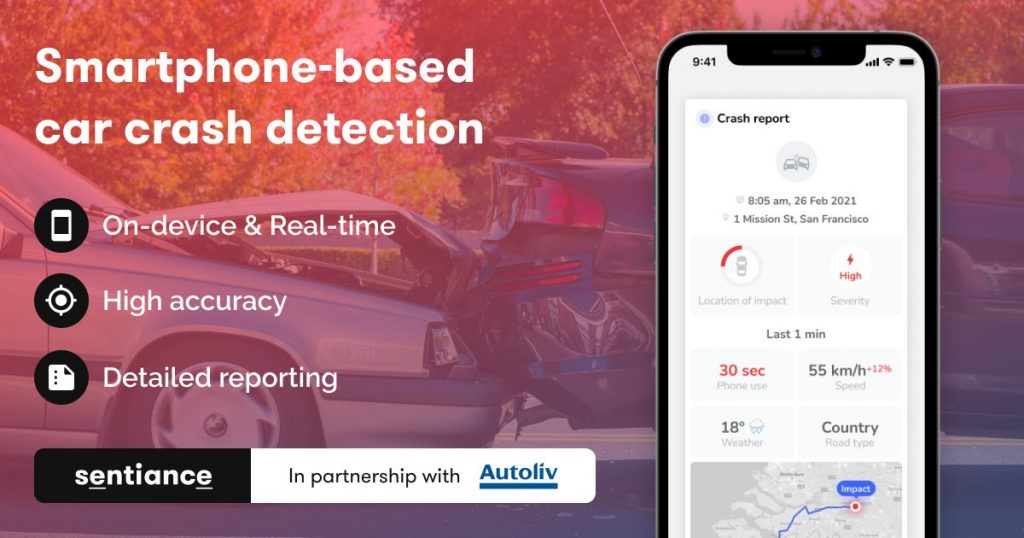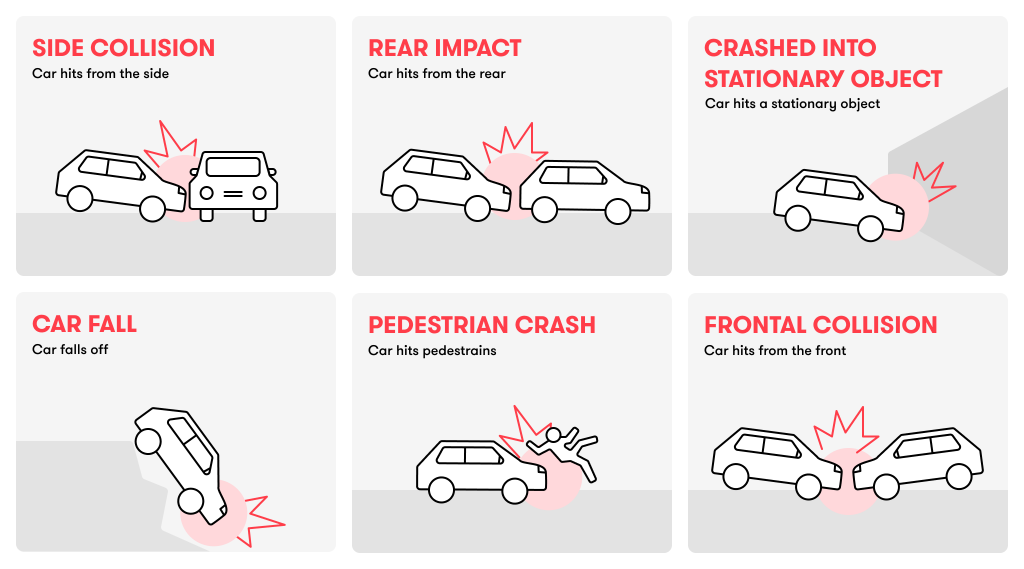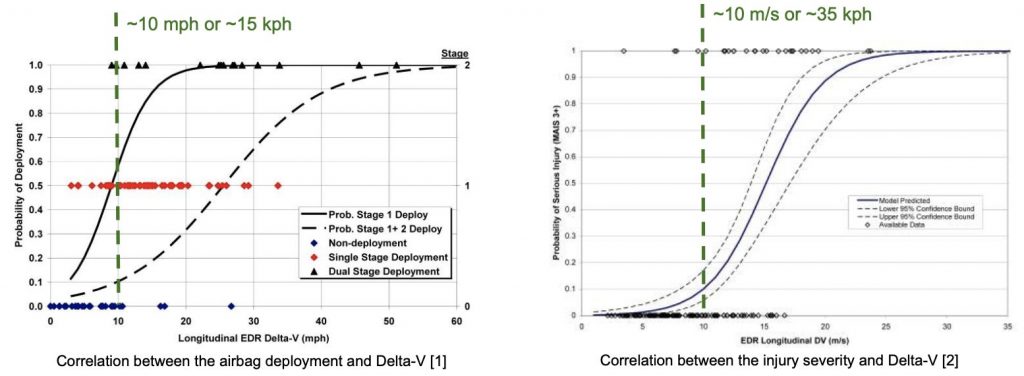Smartphone-based car crash detection by Sentiance and Autoliv

By Arun Ramakrishnan
Why do insurers need crash detection?
Our clients are on a mission to save lives by providing on-time assistance during a crash.
- Making roads safer.
- Supporting families in crash situations.
- Settling insurance claims on time with minimal hustle by better understanding what happened during the crash and what led to it.
Mobile-based crash detection strikes the right note across all our clients who build mobility, insurance and family safety products. Hence, Sentiance has built together with our partner Autoliv the world’s best crash detection solution on mobile devices. We are creating a solution that can not only accurately detect crashes, but also help to build an in-depth crash report with the complete events timeline and context of the crashes.
What is a crash?

A “crash” is a broad term used to describe different types of collisions. Depending on the use case, one type of crash, i.e., major crashes or fender benders, could be of more importance to focus on than others.
Identifying whether a crash was severe enough to have deployed airbags or required emergency assistance is critical. This indicates the scale of the associated consequences, be it monetary, physical or mental suffering. Crash detection can help save lives when every second matters. An insurance company or road assistance app might want to quantify the extent of damages to the car and occupants to optimize their services. But it is not always straightforward to measure them using mobile devices. Therefore we use lots of proxies to measure the severity indirectly (e.g., speed before the impact, peak acceleration or deceleration experienced, and change in velocity).
What’s on the market today?
When we look at mobile-based crash detection solutions on the market today, the definitions of these available solutions can sound ambiguous. Even leading vendors have not clearly defined the types of crashes they focus on. Instead, they vaguely point out that they may not detect all types of crashes, leaving the end-users in limbo. This is mainly due to the limitations of the mobile phone sensors to detect crashes. Often, high-impact user activity or vigorous phone handling could be indistinguishable from a car crash in the sensor data collected by a mobile device. Most of the solutions in the market either use the GPS speed or additional sensors like microphones (Google’s safety hub) to minimize the errors which end up adding additional constraints or privacy concerns about the solution.
Smartphone-based crash detection
Despite the limitations, using mobile phones to detect car crashes can open a new world of opportunities. Unlike the EDRs or black boxes that are rigidly mounted to the cars, mobile devices are often kept closer to the occupants. We can detect crashes irrespective of whether the users drive their car or in other transport modes. More importantly, as we can collect additional data before and after a crash, we can build an elaborate crash storyline. This could include places visited before or after a crash, driving events a few seconds before the crash, such as speeding, phone handling or harsh braking and external factors such as weather or traffic conditions. Thus, helping us to build a user-centric crash solution rather than a car-centric one.
Autoliv and Sentiance partnership
This unique challenging opportunity led to the strong partnership between Autoliv – a world leader in automotive safety and Sentiance – a top innovator in mobile-based motion intelligence.
Our vision is to build a mobile crash solution that can automatically detect crashes, enable high-confidence alerts for first responders and loved ones, and estimate the extent of damages and injuries next to the generation of an accurate crash timeline.

Together, our development work is based on three core principles:
1. Focus on the top use cases of our clients (i.e., claims settlement and emergency assistence).
2. Develop an algorithm that is grounded in scientific literature.
3. Be data-driven and privacy assuring (i.e., advanced machine learning models that can be deployed on-device).
For instance, the initial estimation for the technical parameters of the crash detection solution to model the typical crash types relevant for the businesses like airbag deployment or injury levels are based on the literature [1] and [2]. This was further validated and fine-tuned based on multiple crash datasets, including real-life crash reconstructions, sled tests in Autoliv’s world-class crash lab and real-world Sentiance telematics data hand-picked from one million car trips.

The video below showcases one of the sled tests in the crash lab, along with a snapshot of the recorded accelerometer signals during the impact from the phones placed in multiple positions.
Crash forensics reporting
The human-centric crash report helps insurers to understand the context and potentially the cause of a crash.
- First, we provide the user timeline of transports (car, walk, etc.) and stationaries (home, work, restaurant, etc.) to better understand the events before a crash.
- Second, we zoom into the trip when a crash happened to understand the driving behavior during those trips. This includes an exhaustive list of driving events such as speeding, harsh braking/accelerating, and phone handling along with the corresponding scores.
- Third, we will provide crash forensics of what happened just before the crash, such as the roads/direction in which the user was driving, speed before the impact, impact angle and severity. Besides, we include relevant additional information such as weather and traffic conditions during the crash.
- Finally, we add the venue information of the location after the crash to see whether the user had to seek medical or police assistance. Together, these insights provide a complete picture of crash events.
It’s valuable to understand the cause of a crash. And how impactful would it be if we can prevent a crash before it happens? When combining the human-centric approach and smartphone AI, the possibilities are unlimited. In the future, we could work towards predicting high-risk trips based on the users’ contexts and external factors and minimizing the crash risks by finding alternatives to them. By utilizing behavior Segments to create unparalleled crash forensics from routines, we can visualize the events leading up to the crash. From contextual moments, we can understand and predict the riskiest times to commute. These insights are also valuable across industries.
Today we are already helping family safety providers, auto insurers and insurance providers to manage risks by keeping their customers safe.
Learn more on our crash detection webpage. Get in touch with us today and let’s unlock new possibilities together.
References:
[1] Gabauer DJ, Gabler HC. Comparison of delta-v and occupant impact velocity crash severity metrics using event data recorders. Annu Proc Assoc Adv Automot Med. 2006
[2] Gabler HC, Hinch J. Evaluation of advanced airbag deployment algorithm performance using event data recorders. Ann Adv Automot Med. 2008

